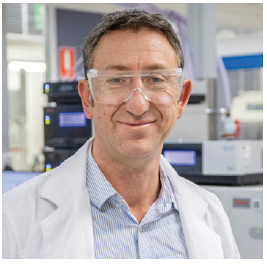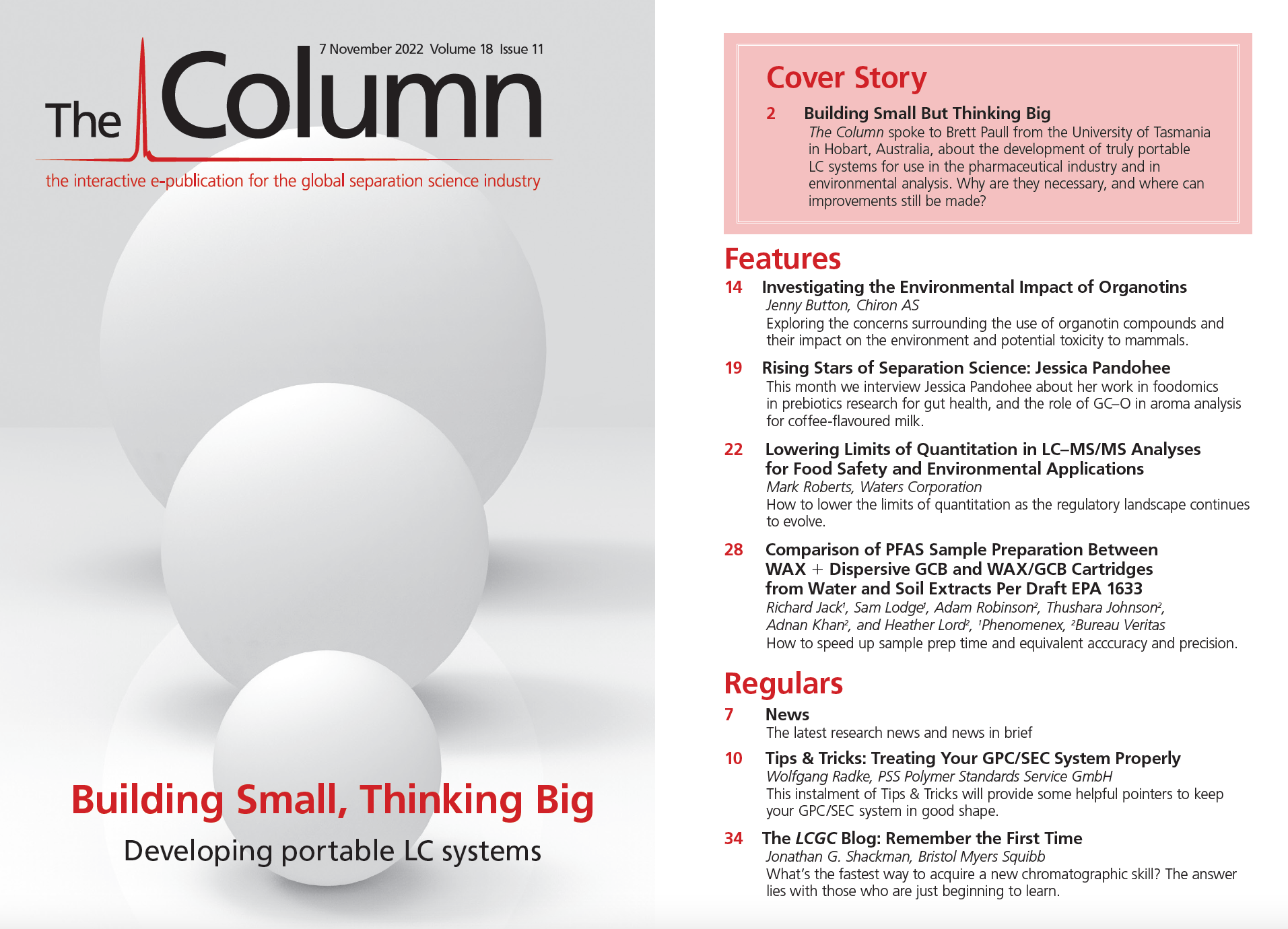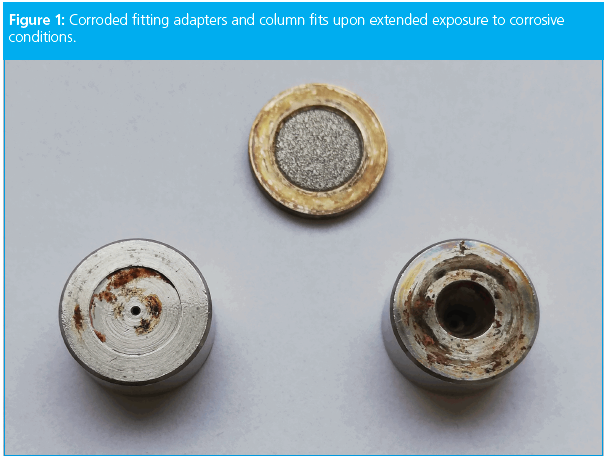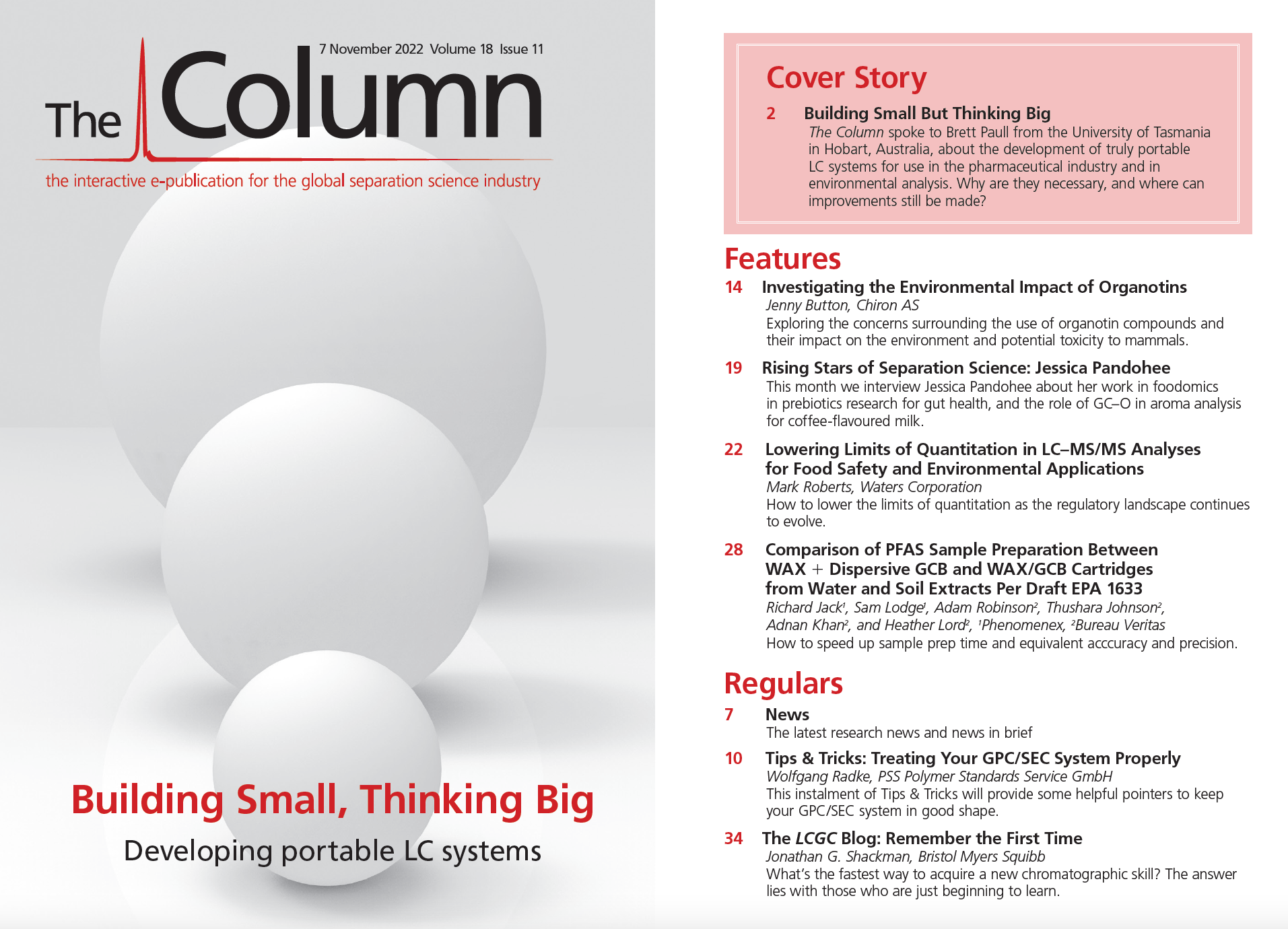Building Small But Thinking Big
The Column spoke to Brett Paull from the University of Tasmania in Hobart, Australia, about the development of truly portable LC systems for use in the pharmaceutical industry and in environmental analysis. Why are they necessary, and where can improvements still be made?
Q. Why is there a need for a small footprint capillary liquid chromatography–ultraviolet–mass spectrometry (LC–UV–MS) system in the pharmaceutical industry?
A: This is a good question; most people’s perception of the pharmaceutical sector is one of massive analytical laboratories packed full of advanced instrumentation and endless resources. However, the pharmaceutical manufacturing industry is changing, and changing to become more responsive and enabled for smaller-scale manufacturing within more diverse locations. This doesn’t sit well with traditional large-scale analytical facilities, and instead demands a move towards greater analytical measurement capability and quality control technology at point of manufacture. In this case that would be in the manufacturing plant itself—as and when the formulations and products are being produced. Of course, this means a different class of chromatographic instrument, and the development of analytical systems that are flexible and robust, easily tailored for specific cases, and operated equally well by production engineers as well as analytical chemists. Given the dynamism and complexity of these smaller manufacturing facilities—including “in-hood”-scale reactions—small footprint and high performance analytical platforms are in demand to help progress this agenda, and top of the list in terms of capability, specificity, and quantitative performance is LC–MS.
Q. What, in your opinion, constitutes a truly portable LC system?
A: Well, how long (or short) is a piece of string? The definition of portability is one that writers of reviews on portable systems—and there are many—struggle to get agreement on. Let’s start with what is not “truly portable”, namely the vast majority of traditional benchtop LC and LC–MS systems that are specifically designed for laboratory use. As such, they are configured for essential supporting infrastructure and connections and the like, and therefore they remain stationary for the majority of their working lifetime. Its hard to describe a 120–150 kg LC–MS system as anything but a non‑portable instrument. In our work we jump between the use of the terms “miniaturized”, “portable”, “deployable”, and even “mobile” to describe our small-footprint analytical platforms, but all have several characteristics in common that support their portability. First, size and scale—typically they are no larger than a standard desktop computer and weigh little enough to be transported by an individual. Second, the time it takes to set up and begin analysis; we try and make this minutes rather than hours— that way the system can be taken from one site to another and get to work immediately, without the need for any specific local “immobile” infrastructure and specialist services. Plug‑and-play and battery operation add to this capability but aren’t primary needs; however, robustness and reliability are very important when an instrument needs to be able to move around.
Q. In a recently published paper, you detail the development of a portable “briefcase-sized” capillary LC system with a UV-LED-based absorbance detector, simultaneously coupled with a small portable mass spectrometer (1). What challenges did you face in its development?
A: This has been quite a long project—which continues today—and multiple systems of increasing complexity and performance have been developed over the past few years. First off the bat, find a worldly-wise industry partner to collaborate with, as any project on instrument development rapidly gets to a point where academics and research students run out of resource puff on their own. In terms of portable LC, there are many challenges. When attempting to reduce the physical scale of the instrument it was clear from an early stage in the project that we needed to be using a capillary format so that we didn’t have to deal with large volumes of solvents, and so we could also downsize the pumps—in our case moving to simpler syringe-based pumps to deliver a gradient option. This offers great advantages but comes with a price—that being building robustness into smaller, more delicate modules, such as small-scale switching valves, capillary tubing, and connections, and capillary-scale absorbance detection. All of this has been achieved, but a lot of lessons have been learned. With portable MS we needed to look to utilize a system that was self-supporting, such as internal vacuum pumps, and with minimal external inputs required—in our case a small nitrogen cylinder and a portable (petrol) power generator. Once again, a system with very rapid start-up and equilibrium times was essential—typically under 30 min—otherwise it wasn’t going to work. Luckily, we identified a perfect companion MS system for our portable LC platform, and we had a portable LC–MS option that we could start-up and use in the field (literally) in under 30 min.
Q. How does the system perform when compared with a standard system?
A: Quantitatively, as shown within our perfluoroalkyl and polyfluoroalkyl substances (PFAS) paper using the system (2), the results obtained were pretty much spot on when compared to laboratory analysis on a large commercial instrument. What we could never hope to match would be top‑end chromatographic performance. We don’t claim to deliver separation efficiencies of a modern ultrahigh-pressure liquid chromatography (UHPLC) system, but that’s actually rarely ever necessary in most cases you can think of. Certainly, within the pharmaceutical sector, most separations include under five peaks! The system we have developed can match standard high performance liquid chromatography (HPLC) in terms of speed and selectivity—and detector sensitivity in most instances—and, of course, surpasses most standard systems in terms of
reduced solvent usage and costs.
Q. Was the UV-LED-based absorbance detector you are utilizing the one you developed for the paper published in 2020 (3)? If so, could you talk a little about why you developed it, why it was needed, and its potential applications in other areas?
A: Essentially yes, but in fact we have developed a number of LED-based absorbance detectors over the years— in fact one for every new generation of deep‑UV-LED. As the LEDs available move ever closer to the magical 200 nm region, the housing and peripherals of the detector require modification, and we have become somewhat expert at this. The latest version of the portable LC platform being developed has options for various detector configurations—either LED-based, or indeed miniature diode array capability—designed to suit the needs of the end user. The benefit of any LED-based absorbance detector lies in its size and cost. LEDs—even deep-UV LEDs—are cheaper than traditional light sources, such as deuterium lamps, and their semi-monochromatic emission simplifies the detector considerably, reducing the need for filters or monochromators. Coupled with low power demands, it’s the obvious choice for portable platforms. Looking to the future, application areas of LED-based absorbance detectors will continue to expand as the emission wavelengths of commercial LEDs continue to decrease, since most small molecules will then have some absorbance within the LED wavelengths available.
Q. Are there any limitations to the system or areas where further improvement could be achieved?
A: There are always improvements to be made. Future interactions of portable instruments will no doubt see improved efficiency, selectivity, and sensitivity— much like constant evolution of standard lab-based systems. Clever engineering will probably make such portable systems even smaller and lighter, and as with all analytical instrumentation, the need for reliability, robustness, and user-friendly operation will see continuing attention placed upon these as well. What still requires attention and innovation is the sample handling and preparation aspects of on-site chromatographic analysis. The development of automated, fast, and intelligent sample handling and preparation solutions to run alongside such portable instruments is still an area requiring much attention.
Q. Further to deploying a portable system for pharmaceutical analysis, you have also utilized a portable capLC–MS system for environmental analysis, specifically the detection of PFAS in soil (2). What are the challenges when analyzing PFAS in the field with such a system?
A: Actually, it wasn’t as hard as we thought it might have been. We managed to source a number of small portable accessories required for sample prep, including a small battery‑operated balance for weighing the samples and a small battery-operated sonic probe for sonic-enhanced solvent extraction from the soils. We then simply needed a small nitrogen cylinder and a small common petrol generator for power. Put all this together in the back of an ute or small van and we were totally mobile. We had run plenty of laboratory tests first to ensure recoveries were acceptable, and so we were confident analytically that the system was fit for purpose. The only challenges the guys faced were where to start digging without causing locals to start worrying, or local dog walkers to start asking too many questions!
Q. How did the developed system and method perform?
A: As I alluded to above, for this particular application we were lucky enough to acquire a large number of soil samples, which had been previously analyzed for PFAS using a high-end laboratory LC–MS system from a commercial laboratory (2). We extracted and analyzed these samples blind and then compared results. The agreement was excellent, which gave us great satisfaction given the differences in the sophistication and complexity of the two systems. For sure we had ourselves a practical, portable, and deployable platform for on-site evaluation of soil and sediment PFAS contamination.
Q. Are there any other considerations necessary such as with sample preparation?
A: Again, as with all samples, attention needs to be given to this, as the answer is only ever as good as the sample tested. Solid samples, and particularly complex solid samples such as soils, always present the most challenging samples for chromatography. For the application of portable instrumentation in the field—in this case for environmental analysis—where and when the analysis takes place is also hugely significant. There’s no easy answer to this, only local knowledge, and a good sampling plan—plus a good deal of method validation on the lab bench before heading out into the field is always advisable.
Q. What are you currently working on?
A: We continue to work with our partners on improvements and new applications of the latest system, but simultaneously we are working on new capabilities in LED‑based detection, including multi‑LED‑based detection and small‑footprint multi‑modal detection options for capillary chromatographs. Most excitingly, we have just been awarded research funding to establish a postgraduate research training centre focused upon “hyphenated analytical separation technology” (HyTECH), which is supported by several leading instrument manufacturers, and within which further development of the portable hyphenated technologies will play a part.
References
- M. Hemida, P.R. Haddad, S.C. Lam, et al., Journal of Chromatography A 1656, 462545 (2021).
- M. Hemida et al., Anal. Chem. 93, 12032−12040 (2021).
- M. Hemida et al., Anal. Chem. 92, 13688−13693 (2020).
Brett Paull

Brett Paull is a University of Plymouth (UK) B.Sc. (Hons), Ph.D. (1994), and D.Sc. (2013) graduate. Brett took up his first lectureship in 1995 at the University of Tasmania. In 1998, he moved to Dublin City University (DCU), Ireland, as a lecturer in analytical science, where he was promoted to senior lecturer in 2003 and associate professor in 2006. In 2011, Brett rejoined the University of Tasmania as a full professor in analytical chemistry under the university’s then “New Stars” programme. He simultaneously held the roles of Director of the ARC Training Centre for Portable Analytical Separation Technologies (ASTech) 2015–2020, and Director of the Australian Centre for Research on Separation Science (ACROSS) 2014–2019. From 2023, Brett will take up the role of Director of the ARC Training Centre for Hyphenated Analytical Separation Technologies (HyTECH). Brett’s 329 published works includes 286 peer‑reviewed journal publications and two research monographs published by the RSC.

University of Rouen-Normandy Scientists Explore Eco-Friendly Sampling Approach for GC-HRMS
April 17th 2025Root exudates—substances secreted by living plant roots—are challenging to sample, as they are typically extracted using artificial devices and can vary widely in both quantity and composition across plant species.
Sorbonne Researchers Develop Miniaturized GC Detector for VOC Analysis
April 16th 2025A team of scientists from the Paris university developed and optimized MAVERIC, a miniaturized and autonomous gas chromatography (GC) system coupled to a nano-gravimetric detector (NGD) based on a NEMS (nano-electromechanical-system) resonator.
















